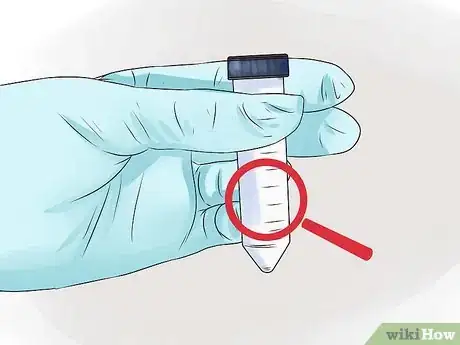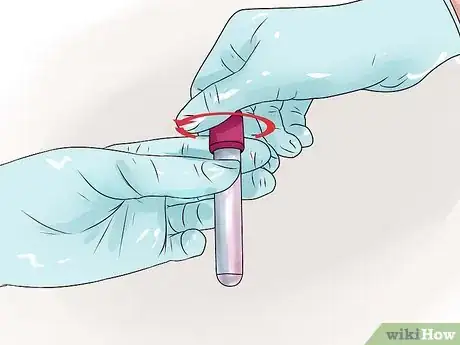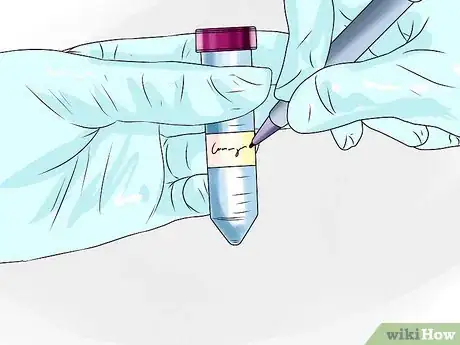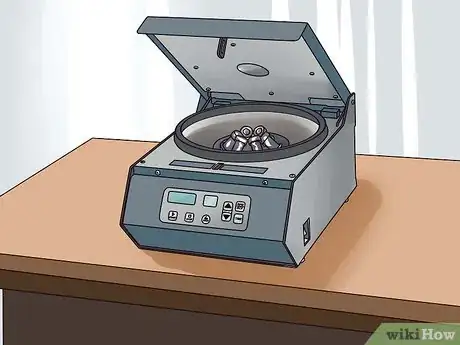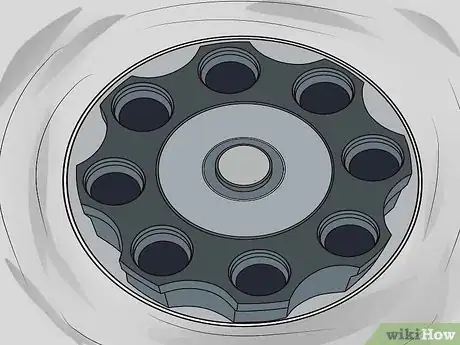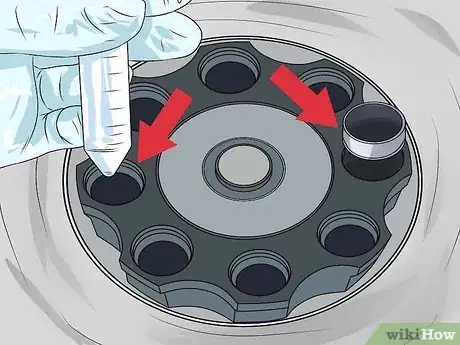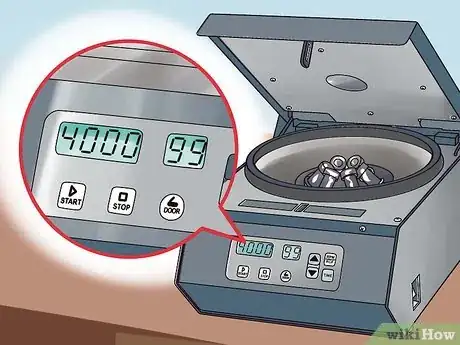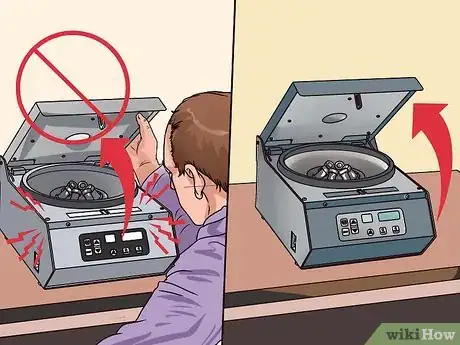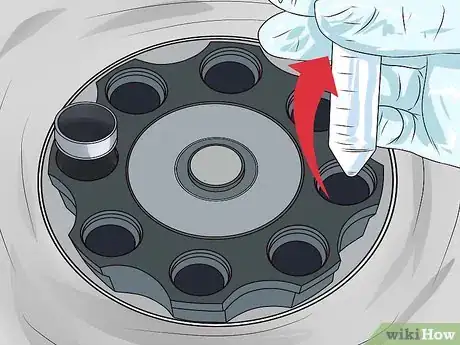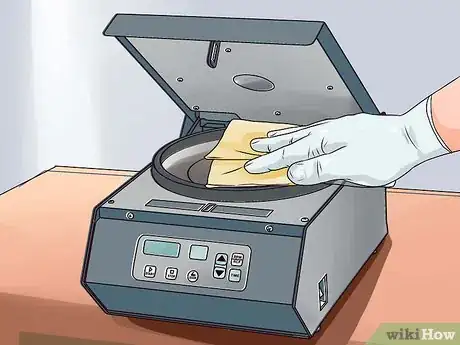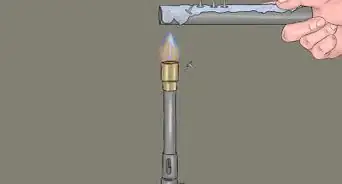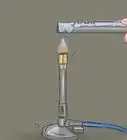This article was co-authored by Bess Ruff, MA. Bess Ruff is a Geography PhD student at Florida State University. She received her MA in Environmental Science and Management from the University of California, Santa Barbara in 2016. She has conducted survey work for marine spatial planning projects in the Caribbean and provided research support as a graduate fellow for the Sustainable Fisheries Group.
There are 7 references cited in this article, which can be found at the bottom of the page.
wikiHow marks an article as reader-approved once it receives enough positive feedback. In this case, 89% of readers who voted found the article helpful, earning it our reader-approved status.
This article has been viewed 240,424 times.
A centrifuge is a type of research equipment that spins a liquid suspension at high rotation rates to separate it into distinct layers based on density.[1] Because of these high rotation rates, centrifuges are delicate, can break easily, and can be dangerous when used improperly. Following some simple operating guidelines should prevent any injuries during their use.
Steps
Preparing and Loading Samples
-
1Inspect centrifuge bottles and tubes for cracks before use. Because a centrifuge can spin at such high speeds, a liquid sample can easily become an aerosol if it is not properly contained. Cracked tubes can fracture at high speeds or at the very least, leak liquid into the rotor.[2]
- Discard broken or cracked tubes to prevent them from accidentally being used in the future.
-
2Cap tubes with the proper lid. Tubes that have been specified for use with a centrifuge have a proper cap or lid that seals the tube. Using a different lid or covering such as saran wrap or foil can easily lead to spills within the centrifuge.[3] Making an aerosol of your sample can be hazardous to your health and the environment. In addition, it can lead to loss of precious samples.Advertisement
-
3Wipe the outside of the tube with disinfectant before placing it in the centrifuge. Wiping the tube is particularly important if you are working with a biohazardous material.[4] You want to limit any possible spills or aerosol formation of your sample. The best prevention is to wipe down the sample with a proper disinfectant before the spin begins.
-
4Clearly label tubes for identification. You may know how you placed your tubes into the centrifuge before they started spinning, but at the end of the spin you will not be able to tell them apart. Make sure you put some sort of label on each tube so you know which sample is which.[5]
- It is best to label the tube directly instead of using a sticker. A sticker can fall off during the spin making identification difficult.
-
5Make a counterbalance for the centrifuge tube you want to put in the centrifuge. At high speeds, a centrifuge can easily become unbalanced if there aren't equal masses opposite each other in the rotor. Remember to balance the masses of the tubes, not the volumes. Weigh the tube with your sample and record the mass. Add water to a separate empty tube until the mass is the same as your sample, and label it as a balance tube.[6]
- Unbalanced tubes can lead to permanent damage of the centrifuge and can be hazards if the rotor breaks free from the rest of the centrifuge.
- Balancing is extremely important at higher centrifugation speeds.
- Many centrifuges will automatically turn off if it senses an unbalanced load, but older ones may not have this feature. If the centrifuge begins to shake or wobble, it is off balance and you should stop it immediately.
Using the Centrifuge
-
1Place the centrifuge on a firm, level surface. Because of the high speeds at which the centrifuge spins, it needs to be housed on a solid, flat surface. Find a level table or counter that is secure and can properly support the weight of the centrifuge.
- If you notice the centrifuge sliding around or the counter underneath sagging, relocate the centrifuge to a more stable place.
-
2Choose the proper rotor to use at the speed you need. The rotor is the piece that spins your sample. Some rotors have arms that you can attach smaller buckets to, while other rotors are one piece that you place the tubes directly into. Rotors are designated for specific tubes and speeds. Use a rotor that fits the tubes of your sample and is within the limit of speed needed.
- If your samples are in the wrong type of tube, you may need to transfer them to the proper type before spinning.
-
3Load the tubes opposite each other in the centrifuge. If you are only spinning 1 sample, you will need to make a balance tube to load directly opposite the sample tube. If you are spinning more than 2 tubes, only the ones directly opposite each other have to be equal in mass.
-
4Enter the centrifugation speed. Centrifugation speed is often given in rotations per minute (rpm), or how many times the rotor completes a full rotation in one minute. Speed can also be given in relative centrifugal force (RCF) or the G-force on the rotor.[7] Modern day centrifuges are digital and have settings for both.
- The speed at which you spin your samples is dependent upon what you are spinning. Do some online research if you aren't sure what speed to use.
-
5Keep a safe distance while the centrifuge is running. Bumping or moving the centrifuge during use can cause an imbalance and lead to injury.[8] Larger centrifuges can spin at very high speeds and are extremely dangerous if they become unbalanced.
-
6Turn off the centrifuge if it is wobbling. After starting the centrifuge, stay close until it gets up to full speed in case it needs to be turned off. When a centrifuge is off balance it may shake or wobble. This can damage the equipment and can also lead to injury in severe cases. If you cannot get to the power button, simply unplug the centrifuge.[9]
- Many centrifuges will automatically turn off if it senses an unbalanced load, but older ones may not have this feature. If the centrifuge begins to shake or wobble, it is off balance and you should stop it immediately.
- A small amount of vibration is normal, but excessive wobbling is dangerous.
- If your samples are balanced and the wobble still occurs, stop using the centrifuge and call for maintenance.
-
7Open the lid only after the rotor has completely stopped. Many modern centrifuges have a lock on them that will not unlock until the rotor has come to a stop. Older centrifuges may not have this feature so make sure the rotor is no longer moving before opening the lid. Do not touch the rotors while they are moving.[10]
- Keep power cords away from the ground to avoid trip hazards that could move the centrifuge.
-
8Remove the tubes carefully after the centrifuge has completely stopped spinning. You want to gently remove the tubes so that the separated suspensions do not mix again. You also want to check to see if any of the samples have leaked or tubes have broken.[11]
- If a spill occurs, clean the rotor and buckets immediately.
-
9Wipe down the rotor and centrifuge after each use. To keep the centrifuge clean and running smoothly, lightly clean the rotor and wipe down the centrifuge at the end of a run. When you are finished, leave the lid open so it can air out and remain dry.[12]
Expert Q&A
Did you know you can get expert answers for this article?
Unlock expert answers by supporting wikiHow
-
QuestionWhat are the centrifugal and centripetal forces?
 Bess Ruff, MABess Ruff is a Geography PhD student at Florida State University. She received her MA in Environmental Science and Management from the University of California, Santa Barbara in 2016. She has conducted survey work for marine spatial planning projects in the Caribbean and provided research support as a graduate fellow for the Sustainable Fisheries Group.
Bess Ruff, MABess Ruff is a Geography PhD student at Florida State University. She received her MA in Environmental Science and Management from the University of California, Santa Barbara in 2016. She has conducted survey work for marine spatial planning projects in the Caribbean and provided research support as a graduate fellow for the Sustainable Fisheries Group.
Environmental Scientist
-
QuestionHow do I stop my centrifuge from spinning if it is not stopping?
 Bess Ruff, MABess Ruff is a Geography PhD student at Florida State University. She received her MA in Environmental Science and Management from the University of California, Santa Barbara in 2016. She has conducted survey work for marine spatial planning projects in the Caribbean and provided research support as a graduate fellow for the Sustainable Fisheries Group.
Bess Ruff, MABess Ruff is a Geography PhD student at Florida State University. She received her MA in Environmental Science and Management from the University of California, Santa Barbara in 2016. She has conducted survey work for marine spatial planning projects in the Caribbean and provided research support as a graduate fellow for the Sustainable Fisheries Group.
Environmental Scientist If for some reason the power button is not working, unplug the centrifuge. The centrifuge will eventually stop spinning once its source of power is removed, even if the momentum of the centrifuge keeps it spinning for a little bit. Do not try to stop the centrifuge with your hands or any other objects. It will eventually stop so just be patient.
If for some reason the power button is not working, unplug the centrifuge. The centrifuge will eventually stop spinning once its source of power is removed, even if the momentum of the centrifuge keeps it spinning for a little bit. Do not try to stop the centrifuge with your hands or any other objects. It will eventually stop so just be patient. -
QuestionWhy is a heater used in a centrifuge machine?
 Community AnswerThe heater is used to keep samples at a certain temperature, often to make it easier to mix substances together.
Community AnswerThe heater is used to keep samples at a certain temperature, often to make it easier to mix substances together.
Warnings
- Unbalanced centrifuges may slowly move across the surface it's on. Immediately shut down unbalanced centrifuges to prevent damage to the machine, you, and those around you.⧼thumbs_response⧽
- Do not lean on the centrifuge or place objects on the centrifuge while it is operating.⧼thumbs_response⧽
- Do not put stoppers or other items in the centrifuge with your tubes.⧼thumbs_response⧽
Things You'll Need
- Centrifuge
- Centrifuge tubes
References
- ↑ https://fas.org/issues/nonproliferation-counterproliferation/nuclear-fuel-cycle/uranium-enrichment-gas-centrifuge-technology/centrifuge-works/
- ↑ https://handling-solutions.eppendorf.com/sample-handling/centrifugation/safe-use-of-centrifuges/centrifuge-safety/
- ↑ http://blink.ucsd.edu/safety/research-lab/laboratory/centrifuge.html#Standard-operating-procedures
- ↑ https://handling-solutions.eppendorf.com/sample-handling/centrifugation/safe-use-of-centrifuges/centrifuge-safety/
- ↑ https://handling-solutions.eppendorf.com/sample-handling/centrifugation/safe-use-of-centrifuges/centrifuge-safety/
- ↑ https://web.uri.edu/research-admin/files/Biosafety-Manual-Appendix-D-Safe-Uses-of-Centrifuges-SOP.pdf
- ↑ http://www.sigmaaldrich.com/technical-documents/articles/biofiles/centrifugation-basics.html
- ↑ https://web.uri.edu/research-admin/files/Biosafety-Manual-Appendix-D-Safe-Uses-of-Centrifuges-SOP.pdf
- ↑ https://handling-solutions.eppendorf.com/sample-handling/centrifugation/safe-use-of-centrifuges/centrifuge-safety/
About This Article
To use a centrifuge, start by placing it on a firm, flat surface so that it’s completely level. Next, check each tube to make sure there are no cracks and that it's capped properly, then load them into the slots opposite each other in the centrifuge. Once the tubes are loaded, use the panel on the front of the machine to enter the speed and start the centrifuge. If the machine begins to rock back and forth, turn it off immediately to prevent permanent damage to the centrifuge. Once the machine has stopped spinning, remove the tubes carefully. For tips from our Science reviewer on how to clean a centrifuge after each use, read on!
